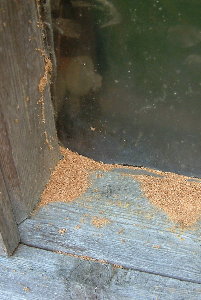

Family: Apidae; Order: Hymenoptera)
 |
Bugs Around Your House
|
 |
|
Carpenter Bees
|
||
|
(Scientific
name: Xylocopa spp;
Family: Apidae; Order: Hymenoptera) |
| Description The carpenter bees are so called because of their exceptional ability to "drill" in wood, producing dust material that is exactly like sawdust. These bees are easily confused with bumble bees because they are robust and about the same size of bumble bee queens. Carpenter bees are 3/4 to 1 inch long, with black or green/blue metalic color. The thorax is usually brightly colored with yellow or white hairs. These features are the same as bumble bees, however the abdomen of carpenter bees are usually hairless and shiny (Fig. 1), while the bumble bee has a hairy abdomen. Carpenter bees are solitary, while bumble bees are social. |
|
|
|
 Fig. 3. Saw dust produced by carpenter bees. Photos by Chris Earley. |
Behavior and biology Both sexes of cartener bees overwinter inside their old nesting holes and emerge in May to June in Michigan to mate. Females forage for nectar and pollen, then mix the two to form a sticky pollen ball. One egg is laid upon the top of ball and the space is sealed to form a cell. The female then backs a little and construct another cell again, with up to 8 such cells per female. Larvae develop on this pollen nectar mix and complete the life cycle in 30-40 days. New adults emerge in August and will hibernate during winter time and mate the next spring. For the next season, adults will use existing holes or disperse to make new holes as their homes. Strong teeth (mandibles) enable them to chew through wood, forming holes around 3/8 to 5/8 inches in diameter (Fig. 2). In the process sawdusts are produced below the hole (Fig. 3). Such nesting holes can be 6 inches to 10 feet deep. Structural damage to wood can occur if many bees nest close together for many years. In addition, they defecate near the hole creating unsighty stains if the nesting holes are near doors or windows. Bees are usually not defensive unless nest is disturbed, although males can fly around people in a erratically way to defend their territory.
Control and prevention The best way to prevent carpenter bee infestation is to cover all exposed wood materials (deck, fence, flower bed, siding, ceiling etc) with heavy paint. The effectiveness is best with oil-based paint, followed by polyurethane and latex-based paint, with woodstain having little effect. Using chemical pressure-treated wood will signicantly reduce infestations. If many nesting holes are already formed, note their precise location during day time and wait till after dark to spray hornet or wasp sprays directly into the hole. Dust forms are more effective due to their longer residual effect, as the new bees emerging in August might not be killed by liquid spray. Dusts such as bendiocarb (Ficam), carbaryl (Sevin), or diazinon can be applied to the nest entrance directly. After activity ceased (best to wait until around September to make sure that the new generation of bees are also dead), seal the holes with chalking material and paint the wood surface. If you are allergic to insect stings, have someone help you or call a pest control firm listed in your yellow pages.
Disclaimer: This fact sheet is for information only. Mention of products does
not indicate endorsement. Prepared by Zachary Huang, Department of Entomology,
Michigan State University, East Lansing, MI 48824, USA. Email: bees@msu.edu.
url: http://cyberbee.msu.edu/column/stinging/carpenterbee.pdf